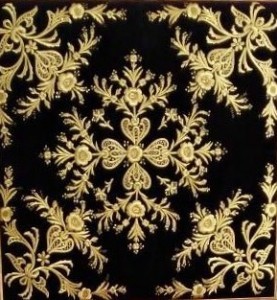
Embroidery is among the arts which show the cultural richness, material mastery, and design capability of Turkish society. It was born out of the use or ornament of fabrics. The oldest examples of Turkish embroidery date back to Seljuks. In the art of embroidery, a pattern is drawn and it is embroidered on fabrics, felt, leather and other fabrics with a variety of needles and application forms, such as a pattern or pattern of silk, wool, linen, cotton, metal (gold-silver). The design obtained is called “nakış”.
There are several methods used in embroidery. One is to draw the desired pattern on a flat surface and fill it with yarns. In another technique, we see making explicit some parts of already styled. Sometimes the embroidery made on some other fabrics are used by sewing them on another fabric. It's called “aplike”. We come across to embroidery mostly on pillows and day bed covers, bed clothings, towels, alongside with fabrics and weavings as household items and wedding dresses which are must-haves in the dowry chest of young girls in Anatolia.
A certain way of embroidery which is applied by materials such as needles, crochet needles, shuttles to the sides of scarves, headscarves and towels is called “oya”. In order for oya to stand upright, either materials such as horsehair and wire are added, or after knitting, hardening materials such as starch, egg whites are used. Among the motifs, the most common ones are plant materials such as flowers, fruits, vegetables, leaves. Sometimes the motifs on oyas refer to some events that symbolize tears, eyelash of the beloved one, railroad tracks, and homesickness.
There are some still-used or forgotten types of embroidery which belong to a certain region. “Balıkesir Pullusu”, one of these, is a wedding dress decorated with scales, worn during the Ottoman period in Balikesir region. These wedding dresses produced until the 1970s have been revived after about half a century.




